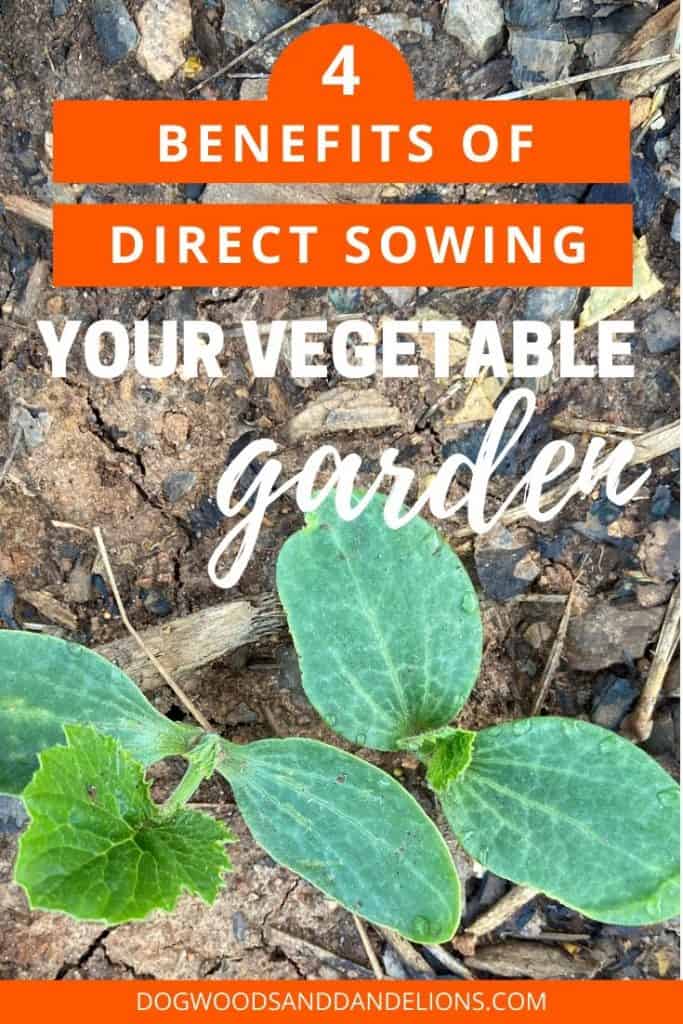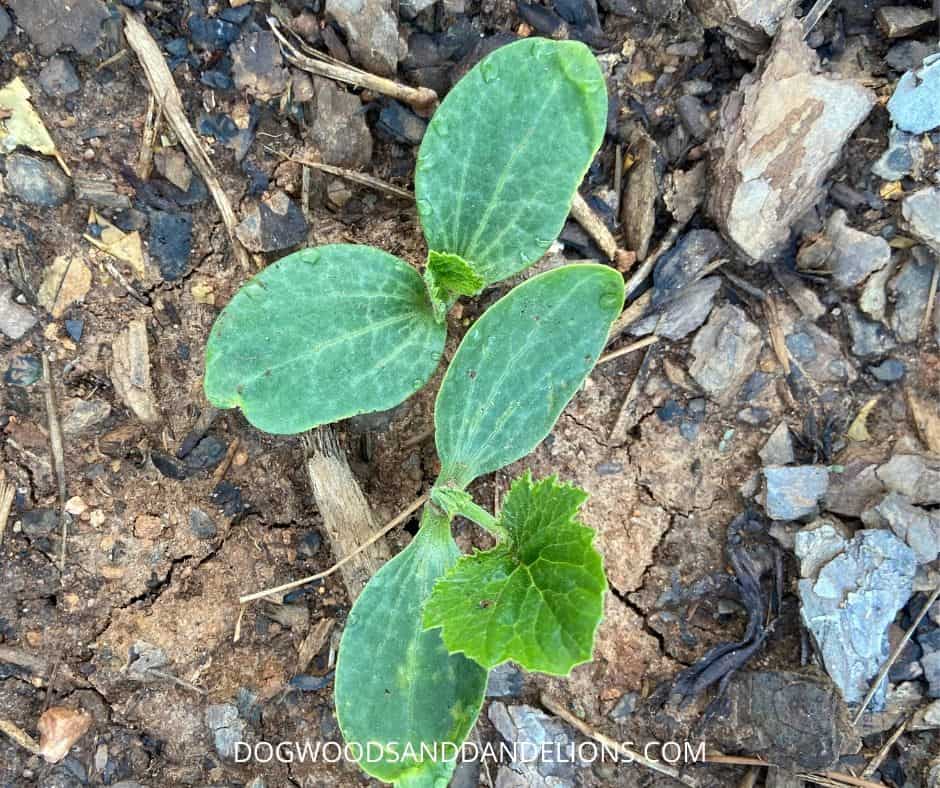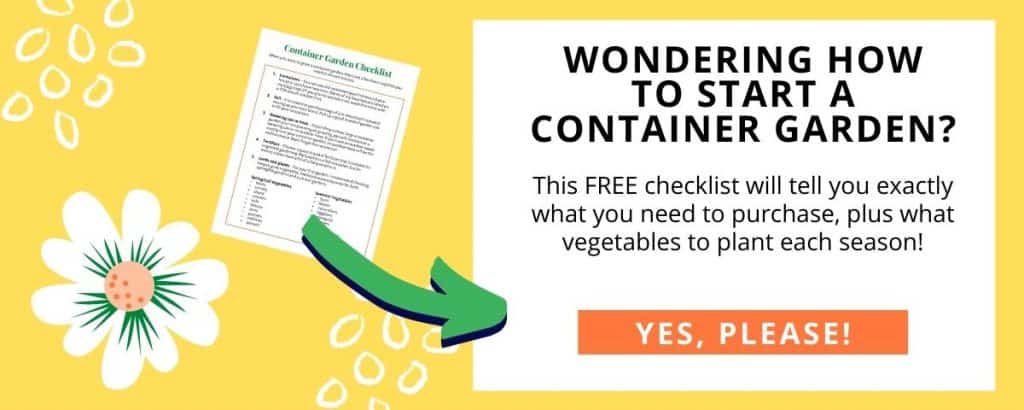Direct Sowing vs. Transplants
Inside: Learn what seeds you should dow directly in the the ground and what vegetables should be planted as transplants.
It can be hard for beginning gardeners to know what should be started as seeds indoors and what should be sown directly in the ground. I’ll explain the benefits and downfalls to direct sowing and share what vegetables you should seed directly in the ground and what you should purchase as transplants.

Affiliate Disclosure: Please note that some of the links in this article may be affiliate links and I may receive a small commission if you purchase something through a link. It will not change your cost. As an Amazon Associate, I earn from qualifying purchases. For more information, see my disclosures page.)
What Does Direct Sow Mean?
First, let’s cover some terminology. Direct sowing is also called direct seeding.
Direct sowing means you plant the seeds directly in the ground or container where you plan to grow the plant for its entire life. This method is best for seeds that are easy to germinate or have long root systems and won’t transplant well.
Direct seeding is different than starting seeds indoors. When you start seeds indoors, you have to have more equipment (such as seed starting trays, grow lights, and seed starting mix) to ensure success.
And eventually, you will have to harden off your seedlings and transplant them into the garden.
Benefits of Direct Sowing
There are many advantages to direct sowing your fruits, vegetables, herbs, and flowers.
Direct Seeding is Cheaper
Probably the first benefit to direct seeding that most people think of is cost. It is so much cheaper to buy a pack of seeds than it is to purchase a 6 pack of transplants (also called “starts”).
You Have More Variety to Choose From
Another benefit to choosing to direct sow your garden is that you have more variety of plants to grow. When you go to a home improvement store, you probably only have 1 or 2 kinds of lettuce plants to choose from.
Your local nursery may carry a few more varieties, but you would be lucky to find more than 3 or 4 different types.
However, if you are willing to direct seed lettuce, you can find many varieties in seed catalogs. One seed catalog I recently looked at had over 35 varieties!
From leaf lettuce to head lettuce to baby lettuce mixes, you have so many choices that you just won’t find in stores.

You Have to Direct Sow Some Crops
And there are just some vegetables that it is almost impossible to transplant. Root crops like beets, turnips, carrots, and parsnips don’t take well to being moved. They MUST be sown directly in the ground.
Other crops have no real advantage to starting seeds early or purchasing transplants so it’s just as easy to seed them directly.
Vegetables like squash, zucchini, and cucumbers, show no real benefit to starting them early indoors. The days to harvest are virtually the same. And direct seeding is much easier than starting seeds indoors under a grow light.

I tested squash one year to see if starting indoors really made a difference versus direct sowing. I started seeds indoors about 3 weeks before my last frost.
As soon as my last expected frost date passed, I planted some seeds directly in the ground and transplanted my squash seedlings on the same day.
Despite having a 3 week head start, I only harvested squash about 4 days sooner from the transplanted seedlings. And it was a lot more work babying them indoors under the grow lights.
Faster to Direct Seed
And some vegetables just take too much room to start early. It would be almost impossible to start enough peas, beans, or corn indoors, even for a small garden.
And it would take soooo long to transplant each little plant into the garden. I don’t have that kind of time or patience.
Unfortunately, you will see many of these plants for sale at garden centers. I almost always see squash, zucchini, cucumbers, and watermelon starts locally. Heck, I’ve even seen corn seedlings for sale. 🙄
No Transplant Shock
When you move plants from a cozy indoor environment to the outside where they experience fluctuating temperatures and wind, sun, and rain, your plants can experience transplant shock.
Harsh wind, the sun beating down on young plants, and too much rain can cause your plants to wither and die.
However, plants that are started from seed directly in the ground don’t have the stress of transplanting and get acclimated to the harsher conditions of the outdoors without having to be hardened off.
Disadvantages of Direct Sowing
However, there are some disadvantages to direct sowing seeds in your garden.
The Soil Isn’t Warm Enough
First, many seeds require the soil to be at a certain temperature before they germinate. If you try to plant them in the ground too early, they may rot in the cool soil.
If you live in a climate that has a short growing season, it may also be difficult to get seeds to germinate and grow large enough to produce a harvest in your short gardening window.
Lots Can Happen While Waiting for the Seeds to Sprout
Another disadvantage to direct seeding is that in the garden, seeds are exposed to all sorts of weather and pest pressure.
Seeds can get washed away in heavy rain. Ants have been known to carry off seeds leaving nothing left to grow.
A sudden cold snap can lower the soil temperature and make the seeds difficult to germinate. And the seeds are competing for nutrients against weed seeds when trying to sprout.
The garden area also needs to be kept moist while the seeds are sprouting. Insufficient or inconsistent watering can cause the seeds to fail to germinate or start sprouting and then die.
You Will Use More Seed

Finally, you will use more seed direct sowing than starting seeds indoors. When you direct sow, you need to use more seed to make up for lower germination rates. The outdoors doesn’t provide the nice consistent temperatures like indoors.
It is also difficult to plant small seeds with exactly the recommended spacing, so I usually plant a bit extra to allow for this. Then, once the vegetables have sprouted, you’ll have to go back and thin the young seedlings.
A Benefit to Purchasing or Growing Transplants
One benefit to buying or growing your own seedlings is that you can get a jump on the start of the growing season. You can get an earlier harvest by planting seedlings.
Purchasing or growing transplants is especially beneficial for slow growing plants or those that have a short growing season or live in cooler climates. The extra time allows you to put healthy plants in the ground at the proper planting time.
For instance, tomato plants take quite a while to start producing fruit. The days to harvest that you see on the seed packet or in the seed catalog mean from the time you TRANSPLANT the plant outdoors. Not from the day you planted the seed.
It can take 4 months from the time you plant tomato seeds until you harvest that first tomato. If you plant that tomato seed directly in the ground, you may have your first frost before you ever get a ripe tomato.
This isn’t the case for most seeds, but tomatoes are different. Be sure to read the seed package carefully.
Plants to Start as Seed Directly in the Garden or in a Container
These are the vegetables and fruits that do best being directly sown in the ground or in a container. While of course, you can start some of these indoors, I’ve found little benefit to starting most of these inside.
The herbs and leafy greens CAN be started indoors if you would like a head start on the growing season and have the space.
- basil
- beans
- beets
- bok choy
- cantaloupe
- carrots
- cilantro
- corn
- cucumbers
- dill
- kale
- lettuce
- okra
- parsley
- parsnips
- peas
- pumpkins
- radishes
- spinach
- squash
- Swiss chard
- turnips
- watermelons
- zucchini
Plant warm season crops outdoors after all danger of frost has passed. Cool-season vegetables can be started earlier. Don’t know the difference? You can learn all about the difference between warm and cool-season crops in this post.

Start Indoors or Purchase Plants
You will notice a few plants on both lists. That is because while you can direct sow some of these, beginning gardeners may find it easier to purchase transplants.
However, if you do want to grow your own transplants to get an early start on the growing season, you can start plants indoors under a grow light.
- basil
- broccoli
- Brussels sprouts
- cabbage
- cauliflower
- cilantro
- eggplant
- lettuce
- peppers
- tomatoes
Flowers That You Can Sow Directly in the Ground or in Containers
If you are looking for a few flowers to add to your regular garden, raised beds, or containers, these flowers are easy to direct seed in your garden.
- cosmos
- marigolds
- morning glories
- nasturtiums
- poppies
- snapdragons
- sweet peas
- sunflowers
- zinnias
How to Direct Sow Seeds in Your Vegetable Garden
Since there are so many advantages to direct sowing, and many vegetables do better starting that way, even most beginning gardeners will want to direct seed at least part of their garden.
First, be sure to sow your seeds at the proper time. Some vegetables need to be grown in cool weather while some must be planted after your last expected frost. Learn more about the difference between cool-season and warm-season vegetables.

To direct sow, you need to prepare your garden bed by loosening the soil. Seeds have a difficult time sprouting in compacted soil.
Remove any weeds from the planting area. Mix in some organic matter such as compost to improve the soil.
Plant the seeds at the depth suggested on the seed packet. Larger seeds tend to be planted deeper than small seeds. Lightly press the soil down on top of the seeds to ensure good contact with the soil.
Water well, but water gently so you don’t wash the seeds away. Label your planting areas using some type of plant marker. (You can make your own plant markers or purchase plant tags that you can write on.)

Each day, check the moisture in your garden and water if it seems the least bit dry. Seeds need consistent moisture to germinate.
Soaking the ground one day and letting it dry out completely before watering again is a disaster for a little seed.
Watch for the seeds to sprout and pull any weeds that pop up. Keep the ground moist, but not soaking wet as the sprouts start to grow.
Before long, you’ll have some beautiful seedlings growing in your garden. Then it’s time for the 3 W’s – weed, water, and wait for the harvest.
What do you direct sow in your garden?
Related Posts
- The difference between cool season and warm season vegetables.
- Want food from your garden quicker? Grow these fast-growing vegetables.
- On a budget? Save money when starting your garden.
- How to understand what you read in a seed catalog.

Meet Julie
I’m a farm girl born and bred in North Carolina. I’ve been growing a vegetable garden for over 20 years (and helping my Mom grow hers even longer). I’ve been raising chickens in my bathtub and backyard for 12+ years. I believe that homegrown food can be made simple. Let’s get started.


Thank you for this!! Great, to the point info!!
I’m so glad you found it helpful!